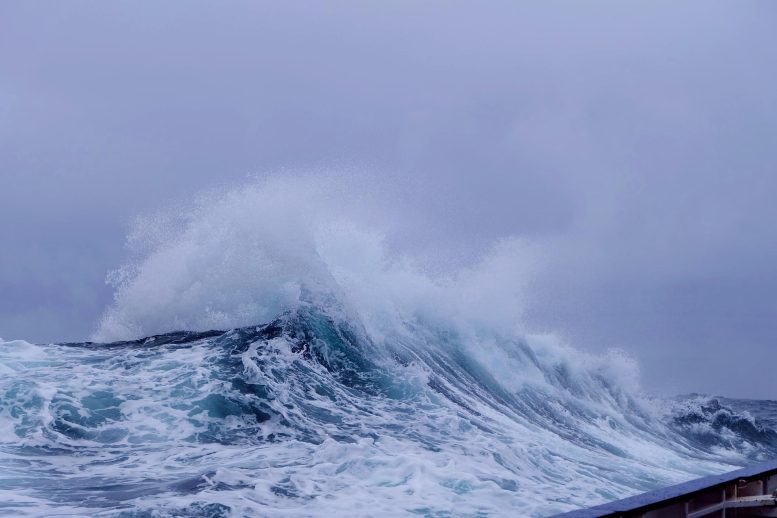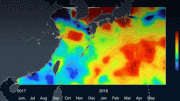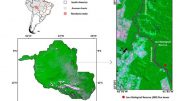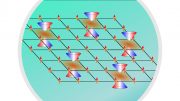
During stormy weather, sea spray can carry microplastics into the air. The photo was taken during a trip of the research vessel Heincke off the Norwegian coast in June 2021. Credit: Alvise Vianello
New research identifies the composition and origins of the microplastics.
Microplastic particles can be found in the marine atmosphere, even in the world’s most isolated regions. These minuscule particles originate from land but are also released back into the atmosphere from the ocean, according to a study led by Dr. Barbara Scholz-Böttcher of the University of Oldenburg, with collaboration from German and Norwegian researchers. The team studied air samples from several locations on the Norwegian coast extending to the Arctic. Their findings were recently published in the journal Nature Communications.
“With our study, we present data on the mass load of different types of plastic in the marine atmosphere for the first time,” said Isabel Goßmann, a doctoral candidate at the University of Oldenburg’s Institute for Chemistry and Biology of the Marine Environment (ICBM) and first author of the paper. The research team collected the samples during an expedition with the Research Vessel Heincke in 2021.
The northernmost destination was Bear Island, the most southerly island of the Svalbard archipelago which lies halfway between the mainland and the archipelago’s largest island, Spitsbergen. The team used two different devices to collect air samples. The devices actively pumped in the air and were mounted on the bow of the research vessel at a height of twelve meters.
Different types of plastics identified
The scientists analyzed the air samples using pyrolysis-gas chromatography-mass spectrometry. With this method, they were able to identify and quantify the different types of plastics in the atmosphere through thermal degradation and selective analysis. They then performed model calculations and reconstructed the sources and distribution paths of the particles, each of which is just a few thousandths of a millimeter in size.
The analysis revealed the omnipresence of polyester particles. Polyethylene terephthalate particles, which presumably entered the atmosphere in the form of textile fibers, were detected in all samples. Other plastic types were also present, including polypropylene polycarbonate and polystyrene.
Tire wear particles, the tiny debris abraded from tires during driving and especially braking, were identified as another major source of microplastics. The researchers measured concentrations of up to 37.5 nanograms (one nanogram = one-billionth of a gram) of microplastics per cubic meter of air.
“These pollutants are ubiquitous. We find them even in remote polar regions,” Goßmann stressed.
Until now, little was known about microplastic pollution levels including tire wear particles in the marine atmosphere. “There are only a handful of studies on the concentration of these pollutants in the air,” said team leader Scholz-Böttcher. “Our model calculations indicate that the microplastics in the marine atmosphere come from direct sources on the land as well as from the sea,” she added. The team posits that plastic particles floating near the sea surface enter the atmosphere via sea spray and bursting air bubbles produced during stormy weather, for example.
Ships are also a source of microplastics
Microplastics find their way into seawater via rivers, but also through the atmosphere – particles are washed out of the atmosphere by rain, for example. Another potential source is ship traffic: in an earlier study, a team led by Scholz-Böttcher demonstrated that in the open North Sea, the paint and coatings used on ships is the main source of microplastics. In the current study, chemicals such as polyurethanes and epoxy resins typically used in paints and coatings for ships were also found in the air samples.
Reference: “Occurrence and backtracking of microplastic mass loads including tire wear particles in northern Atlantic air” by Isabel Goßmann, Dorte Herzke, Andreas Held, Janina Schulz, Vladimir Nikiforov, Christoph Georgi, Nikolaos Evangeliou, Sabine Eckhardt, Gunnar Gerdts, Oliver Wurl and Barbara M. Scholz-Böttcher, 22 June 2023, Nature Communications.
DOI: 10.1038/s41467-023-39340-5
In addition to researchers from the ICBM, scientists from the Alfred Wegener Institute, Helmholtz Centre for Polar and Marine Research (AWI) in Bremerhaven, the Technische Universität Berlin, the Norwegian Institute for Air Research (NILU) and the Norwegian Institute of Public Health (NIPH) were also part of the research team.









We need to stop making and using plastic as soon as possible. Alternatives need to be found.
it also means theres a possibility that these can be harvested and turn them back into usable materials.
Terracycle collects cigarette butts and removes the micro plastics. These micro plastics are turned into playground equipment, benches and various other products. We have collected 1000 lbs of butts from the streets of our small town since last October. One butt off the ground is a celebration. Terracycle recycles other plastics as well. See their website, they are world wide
The microplastics are there because we dump grounded up trash there despite any harm it causes and of course it’s going to be in isolated places the water current and carries debris with it then the government says we have a problem but yet they caused the problem f***ing idiots
Aside from regular tire wear, could the particles related to tire compounds also be introduced into the atmosphere from those horrible burn out shows and drag cars that burn tires at the line every time? Not to mention the random civilians that also burn their tires with high horsepower cars and emit plumes of burnt rubber pollution into the air?
Is it a possibility that if it were quantifiable, that those shows and people produce half or more tire pollution particles than the whole nations annual output? Just a thought. These shows are all over the world, as well as drag racing, and also the sport of drifting (forgot to mention this above) but I can imagine this would be a significant contribution nonetheless.
Or how about the fact that SALT HAS MICRO PLASTICS…. yes even your table salt has micro plastics. Stop letting other tell you how to think!! You people are so brain washed that you automatically blame man yet you refuse to educate yourselves to possible natural causes. Which I this case, it is natural causes. Someone just wanted a huge pile of grant money, in the name of “science” and got rich telling everyone what everyone should already know. Stop being a sheep.
James, you haven’t backed up that off the cuff statement w/hard evidence. Not at least a link to substantiate you claim. It sounds or looks like it’s leaning towards those who are in denial of this Climate Emergency we’re ALL witnessing whether Some think it’s there or not
So much for the deep-breathing-in the good ocean air during my beach walks!
Well, yet another one that bites the dust… literally.
Tires aren’t plastic, they’re primarily made from rubber. But other than that, mankind will undoubtedly kill themselves off as a species. Hopefully the next dominant species to arise millions of years later will be smarter.
Tires aren’t made entirely of natural rubber. They are a combination of natural and synthetic rubber. This synthetic rubber is made from polymers (typically non biodegradable) and when these synthetic rubbers break down they eventually end up breaking down into non biodegradable micro-polymers which are lumped into the classification of micro-plastics.